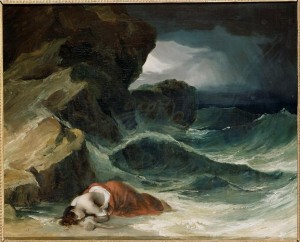by Elizabeth Goldsmith (Regular Contributor)
 Shipwrecked women were popular in early fiction and drama. Stories of women washed up on foreign shores fascinated early modern readers. In painting, the image of a barely clothed female figure tossed up on a beach was also a favorite subject. Unlike their male counterparts who were often depicted stunned but alive and staggering toward some kind of future, shipwrecked women were usually unconscious or dead, as in the painting The Storm by Théodore Géricault.
Shipwrecked women were popular in early fiction and drama. Stories of women washed up on foreign shores fascinated early modern readers. In painting, the image of a barely clothed female figure tossed up on a beach was also a favorite subject. Unlike their male counterparts who were often depicted stunned but alive and staggering toward some kind of future, shipwrecked women were usually unconscious or dead, as in the painting The Storm by Théodore Géricault.
Perhaps the world’s most famous painting of survivors of a real shipwreck is another one by Géricault, The Raft of the Medusa (1819). The wreck of the frigate off the coast of Senegal on July 2, 1816 became a huge media event back home in  France. Bestselling accounts were written by two of the male survivors, Sauvigny and Corréard. Stories of the crew who abandoned the passengers, and then selectively killed off many who had managed to board the life raft caused great outcry in France. The disaster became a political scandal, as well, when it became known that the inexperienced captain had been given his command as the result of corrupt connections with the Bourbon regime.
France. Bestselling accounts were written by two of the male survivors, Sauvigny and Corréard. Stories of the crew who abandoned the passengers, and then selectively killed off many who had managed to board the life raft caused great outcry in France. The disaster became a political scandal, as well, when it became known that the inexperienced captain had been given his command as the result of corrupt connections with the Bourbon regime.
In the political storm that followed, people lost sight of the fate of some of the ordinary passengers who had survived the disaster. One of these was a young woman named Charlotte Picard, an 18-year-old who had been travelling on the Medusa with her family, accompanying her father who was going to Africa to serve as a clerk in the French colonial administration. Of the nine family members onboard the doomed ship, only four survived the wreck and the immediate months that followed.
 In 1824 Charlotte decided to publish her own account of the events and her family’s subsequent life on an island off the west coast of Africa, titled La Chaumière africaine (The African Cottage). In it she made sure to correct details that had previously circulated. Her rendering of the female survivors is anything but pathetic. The accounts written by Sauvigny and Corréard had lingered over descriptions of the female victims who had been lost to the waves, and boasted about the ones who they personally had been able to save. Charlotte tells her own extended story of terror and adventure on the small boat that her father managed to board with his family, after they were all turned away from the life raft. When they at last approached a shore their boat capsized, and all were washed up on the beach.
In 1824 Charlotte decided to publish her own account of the events and her family’s subsequent life on an island off the west coast of Africa, titled La Chaumière africaine (The African Cottage). In it she made sure to correct details that had previously circulated. Her rendering of the female survivors is anything but pathetic. The accounts written by Sauvigny and Corréard had lingered over descriptions of the female victims who had been lost to the waves, and boasted about the ones who they personally had been able to save. Charlotte tells her own extended story of terror and adventure on the small boat that her father managed to board with his family, after they were all turned away from the life raft. When they at last approached a shore their boat capsized, and all were washed up on the beach.
Charlotte Picard and her little band of relatives lived in Senegal for two years, confronting illness and starvation. They managed to keep themselves going until 1820, when she returned to France. Her version of the famous disaster went beyond the shipwreck story, showing how a woman was able to pick herself up and walk off the beach, making a new life for herself and those who remained with her.
For further reading:
Charlotte (Picard) Dard, La Chaumière africaine ou histoire d’une famille française jetée sur la côte occidentale de l’Afrique à la suite du naufrage de la frégate “La Méduse”, ed. Doris Y. Kadish. Paris: L’Harmattan, 2005.
Jonathan Miles, The Wreck of the Medusa. New York: Atlantic Monthly Press, 2007.
